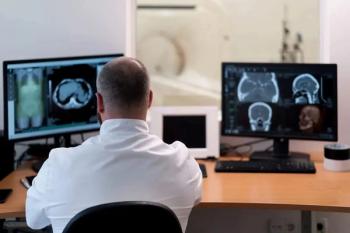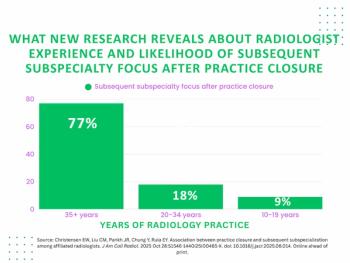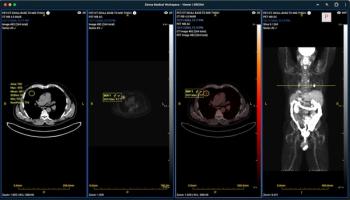
- Diagnostic Imaging Vol 32 No 7
- Volume 32
- Issue 7
CT, MR volumes starting to plunge, several experts say
All across the country high-tech imaging volumes are flat or declining compared with last year.
All across the country high-tech imaging volumes are flat or declining compared with last year. In years past, CT and MR imaging volumes experienced steady growth; but these days radiologists and other radiology stakeholders are noticing a change.
At places such as Wake Forest University Baptist Medical Center in North Carolina, nearly every area of radiology grew by 5% to 7% each year for the past decade. That's not the case anymore. Compared with last year, CT volumes are down 7%, MR volumes are down 5%, and even ultrasound is down 1%.
“This is quite typical of what is happening at many private and public institutions in the Southeast, as best I can tell,” said Dr. Allen Elster, radiology chair at Wake Forest. “Some of the largest private groups in North Carolina are down in both CT and MRI by 10% or more this year.”
The decline is noticeable not just in the Southeast but across the country.
CT and MR volumes plateaued nationwide in the last half of 2009 and started to decline this year, according to Tom Cabot, vice president of Arlington Medical Resources, a medical data company. He declined to provide actual figures.
The hospital market is flat but volume in the nonhospital market, mainly imaging centers, is declining, he said. Some of the drop in hospital CT volumes may have been moderated by increases in coronary CTA, a procedure not generally available in outpatient centers.
Even large companies are feeling the pinch. In its first-quarter earnings call, RadNet, a network of 175 owned and operated outpatient imaging centers in seven states, reported its procedure volumes were down between 5% and 10% from the same period last year. In particular, the first quarter showed a decrease in CT volume of 6.1%.
In a recent poll of 206 U.S. hospital-based administrative directors and managers by The MarkeTech Group, 32% said in the past six months their CT volumes have decreased by up to 10%. Another 27% said they haven't noticed a change.
Many of those surveyed (40%) said the decrease in volume is somewhat related to radiation concerns.
There has been a lot of negative press about CT radiation dose and patients hear the horror stories. That then spills over into the medical community referring fewer CT scans, said Steven Renard, president and CEO of Diagnostic Radiology and Oncology Services, a development, management, and consulting firm with particular expertise in imaging centers.
Even without hard data, anecdotal reports suggest CT dose concerns could be a factor in scan volume reductions.
“It is hard to know what drives these changes-new scanners, poor economy, or radiation consciousness,” said Dr. Fergus Coakley, a professor of radiology and biomedical imaging and the vice chair of clinical services at the University of California, San Francisco. “Nonetheless, having talked to several referring physicians and patients, my sense is that at least some of this is driven by greater fear of radiation, with fewer CTs being ordered. The number of CT scans performed per person in the U.S. is very high, and there is probably scope to reduce this number, partially by switching to MRI.”
Two other factors for declining volumes are that payers want to acquire similar amounts of information with cheaper tests, so they aren't as willing to pay for CTs. Also, patients opt for less expensive tests for economic reasons, Renard said.
Elster concurred.
“Although radiation worries could be driving CT down, it's my guess that it is the economy as a whole, and different patterns of patients going to the doctor and putting off elective and expensive tests,” he said.
Another possible reason for the decline is changes in reimbursement and patients' loss of insurance, said Dr. Wilbur Smith, chair of diagnostic radiology at Wayne State University in Detroit.
“I think we're going to be among the last to fall out of this economic recession by virtue of the fact people don't want to take time off work to go find out what's wrong with them and risk losing their job,” Renard said.
And even once people are employed again, they are not apt to take time off work in the first six months and utilize their insurance because they want to pass their probation periods, he said.
“It's going to be a steep crawl back out,” Renard said.
Articles in this issue
over 15 years ago
Marilyn Monroe's chest x-rays sell for big bucksover 15 years ago
Timothy Leary had nothing on 1950s radiologistover 15 years ago
Algorithm drops number of CTs for some strokesover 15 years ago
Risk factors determine need for CTA for PEover 15 years ago
TeraRecon harnesses cloud to display EMR imagesover 15 years ago
Siemens adds MR transmit channels to boost functionover 15 years ago
Monkeys and dogs and donkeys: Oh CT!over 15 years ago
Is the party over for high-tech imaging's sustained growth?over 15 years ago
Correct Application Of MRI: helps find causes of lower back painover 15 years ago
Outcomes, shmoutcomes - how much do we make?Newsletter
Stay at the forefront of radiology with the Diagnostic Imaging newsletter, delivering the latest news, clinical insights, and imaging advancements for today’s radiologists.





























